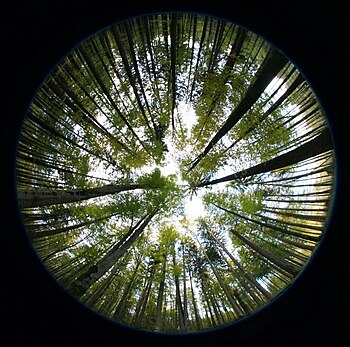
Daylighting is the practice of placing windows, skylights, other openings, and reflective surfaces so that direct or indirect sunlight can provide effective internal lighting. Particular attention is given to daylighting while designing a building when the aim is to maximize visual comfort or to reduce energy use. Energy savings can be achieved from the reduced use of artificial (electric) lighting or from passive solar heating. Artificial lighting energy use can be reduced by simply installing fewer electric lights where daylight is present or by automatically dimming or switching off electric lights in response to the presence of daylight – a process known as daylight harvesting.

A light meter is a device used to measure the amount of light. In photography, an exposure meter is a light meter coupled to either a digital or analog calculator which displays the correct shutter speed and f-number for optimum exposure, given a certain lighting situation and film speed. Similarly, exposure meters are also used in the fields of cinematography and scenic design, in order to determine the optimum light level for a scene.

Thermal radiation is electromagnetic radiation generated by the thermal motion of particles in matter. Thermal radiation is generated when heat from the movement of charges in the material is converted to electromagnetic radiation. All matter with a temperature greater than absolute zero emits thermal radiation. At room temperature, most of the emission is in the infrared (IR) spectrum. Particle motion results in charge-acceleration or dipole oscillation which produces electromagnetic radiation.
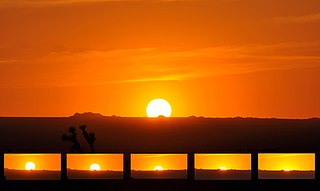
Sunset is the disappearance of the Sun below the horizon of the Earth due to its rotation. As viewed from everywhere on Earth, it is a phenomenon that happens approximately once every 24 hours except in areas close to the poles. The equinox Sun sets due west at the moment of both the spring and autumn equinoxes. As viewed from the Northern Hemisphere, the Sun sets to the northwest in the spring and summer, and to the southwest in the autumn and winter; these seasons are reversed for the Southern Hemisphere.
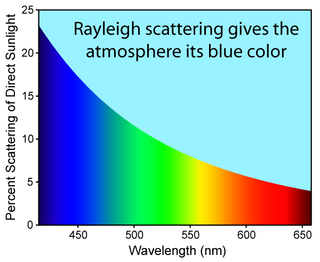
Diffuse sky radiation is solar radiation reaching the Earth's surface after having been scattered from the direct solar beam by molecules or particulates in the atmosphere. It is also called sky radiation, the determinative process for changing the colors of the sky. Approximately 23% of direct incident radiation of total sunlight is removed from the direct solar beam by scattering into the atmosphere; of this amount about two-thirds ultimately reaches the earth as photon diffused skylight radiation.

Remote sensing is the acquisition of information about an object or phenomenon without making physical contact with the object, in contrast to in situ or on-site observation. The term is applied especially to acquiring information about Earth and other planets. Remote sensing is used in numerous fields, including geophysics, geography, land surveying and most Earth science disciplines ; it also has military, intelligence, commercial, economic, planning, and humanitarian applications, among others.

A fisheye lens is an ultra wide-angle lens that produces strong visual distortion intended to create a wide panoramic or hemispherical image. Fisheye lenses achieve extremely wide angles of view, well beyond any rectilinear lens. Instead of producing images with straight lines of perspective, fisheye lenses use a special mapping, which gives images a characteristic convex non-rectilinear appearance.

Within the atmospheric sciences, atmospheric physics is the application of physics to the study of the atmosphere. Atmospheric physicists attempt to model Earth's atmosphere and the atmospheres of the other planets using fluid flow equations, radiation budget, and energy transfer processes in the atmosphere. In order to model weather systems, atmospheric physicists employ elements of scattering theory, wave propagation models, cloud physics, statistical mechanics and spatial statistics which are highly mathematical and related to physics. It has close links to meteorology and climatology and also covers the design and construction of instruments for studying the atmosphere and the interpretation of the data they provide, including remote sensing instruments. At the dawn of the space age and the introduction of sounding rockets, aeronomy became a subdiscipline concerning the upper layers of the atmosphere, where dissociation and ionization are important.
A pyranometer is a type of actinometer used for measuring solar irradiance on a planar surface and it is designed to measure the solar radiation flux density (W/m2) from the hemisphere above within a wavelength range 0.3 μm to 3 μm.

In infrared photography, the photographic film or image sensor used is sensitive to infrared light. The part of the spectrum used is referred to as near-infrared to distinguish it from far-infrared, which is the domain of thermal imaging. Wavelengths used for photography range from about 700 nm to about 900 nm. Film is usually sensitive to visible light too, so an infrared-passing filter is used; this lets infrared (IR) light pass through to the camera, but blocks all or most of the visible light spectrum.
Leaf area index (LAI) is a dimensionless quantity that characterizes plant canopies. It is defined as the one-sided green leaf area per unit ground surface area in broadleaf canopies. In conifers, three definitions for LAI have been used:

In biology, the canopy is the aboveground portion of a plant cropping or crop, formed by the collection of individual plant crowns. In forest ecology, canopy refers to the upper layer or habitat zone, formed by mature tree crowns and including other biological organisms. The communities that inhabit the canopy layer are thought to be involved in maintaining forest diversity, resilience, and functioning. Shade trees normally have a dense canopy that blocks light from lower growing plants.

The normalized difference vegetation index (NDVI) is a widely-used metric for quantifying the health and density of vegetation using sensor data. It is calculated from spectrometric data at two specific bands: red and near-infrared. The spectrometric data is usually sourced from remote sensors, such as satellites.
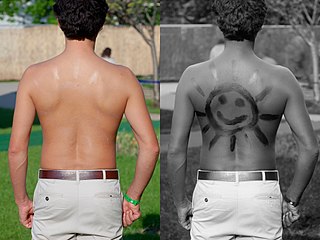
Ultraviolet photography is a photographic process of recording images by using radiation from the ultraviolet (UV) spectrum only. Images taken with ultraviolet radiation serve a number of scientific, medical or artistic purposes. Images may reveal deterioration of art works or structures not apparent under light. Diagnostic medical images may be used to detect certain skin disorders or as evidence of injury. Some animals, particularly insects, use ultraviolet wavelengths for vision; ultraviolet photography can help investigate the markings of plants that attract insects, while invisible to the unaided human eye. Ultraviolet photography of archaeological sites may reveal artifacts or traffic patterns not otherwise visible.
The leaf angle distribution of a plant canopy refers to the mathematical description of the angular orientation of the leaves in the vegetation. Specifically, if each leaf is conceptually represented by a small flat plate, its orientation can be described with the zenith and the azimuth angles of the surface normal to that plate. If the leaf has a complex structure and is not flat, it may be necessary to approximate the actual leaf by a set of small plates, in which case there may be a number of leaf normals and associated angles. The LAD describes the statistical distribution of these angles.

A whole sky camera is a specialized camera used in meteorology and astronomy for capturing a photograph of the entire sky. Another application is that of hemispherical photography to study plant canopy geometry and to calculate near-ground solar radiation.
Sunflecks are brief increases in solar irradiance that occur in understories of an ecosystem when sunlight is able to directly reach the ground. They are caused by either wind moving branches and/or leaves in the canopy or as the sun moves during the day. Although each sunfleck only last for seconds or minutes at a time, they can be responsible more than 80% of the photons that reach plants in the understory, and up to 35% of carbon fixation. This makes them important sources of energy for plants in the understory of forests. The amount of energy that a sunfleck provides depends on their duration, size and shape and the intensity of photosynthetically active radiation (PAR), which itself depends on the arrangement of vegetation in the canopy and the position of the sun in the sky.

The Simple Model of the Atmospheric Radiative Transfer of Sunshine (SMARTS) is a computer program designed to evaluate the surface solar irradiance components in the shortwave spectrum under cloudless conditions. The program, written in FORTRAN, relies on simplifications of the equation of radiative transfer to allow extremely fast calculations of the surface irradiance. The irradiance components can be incident on a horizontal, a fixed-tilt or a 2-axis tracking surface. SMARTS can be used for example to evaluate the energy production of solar panels under variable atmospheric conditions. Many other applications are possible.

The smc Pentax-DA 10-17mm f/3.5-4.5 ED (IF) Fish-Eye lens is a fisheye zoom lens for the Pentax K-mount. It offers an up to 180 degree view, and allows quick shift focus.
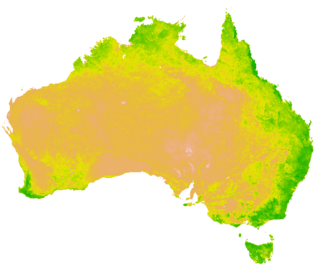
A vegetation index (VI) is a spectral imaging transformation of two or more image bands designed to enhance the contribution of vegetation properties and allow reliable spatial and temporal inter-comparisons of terrestrial photosynthetic activity and canopy structural variations.



